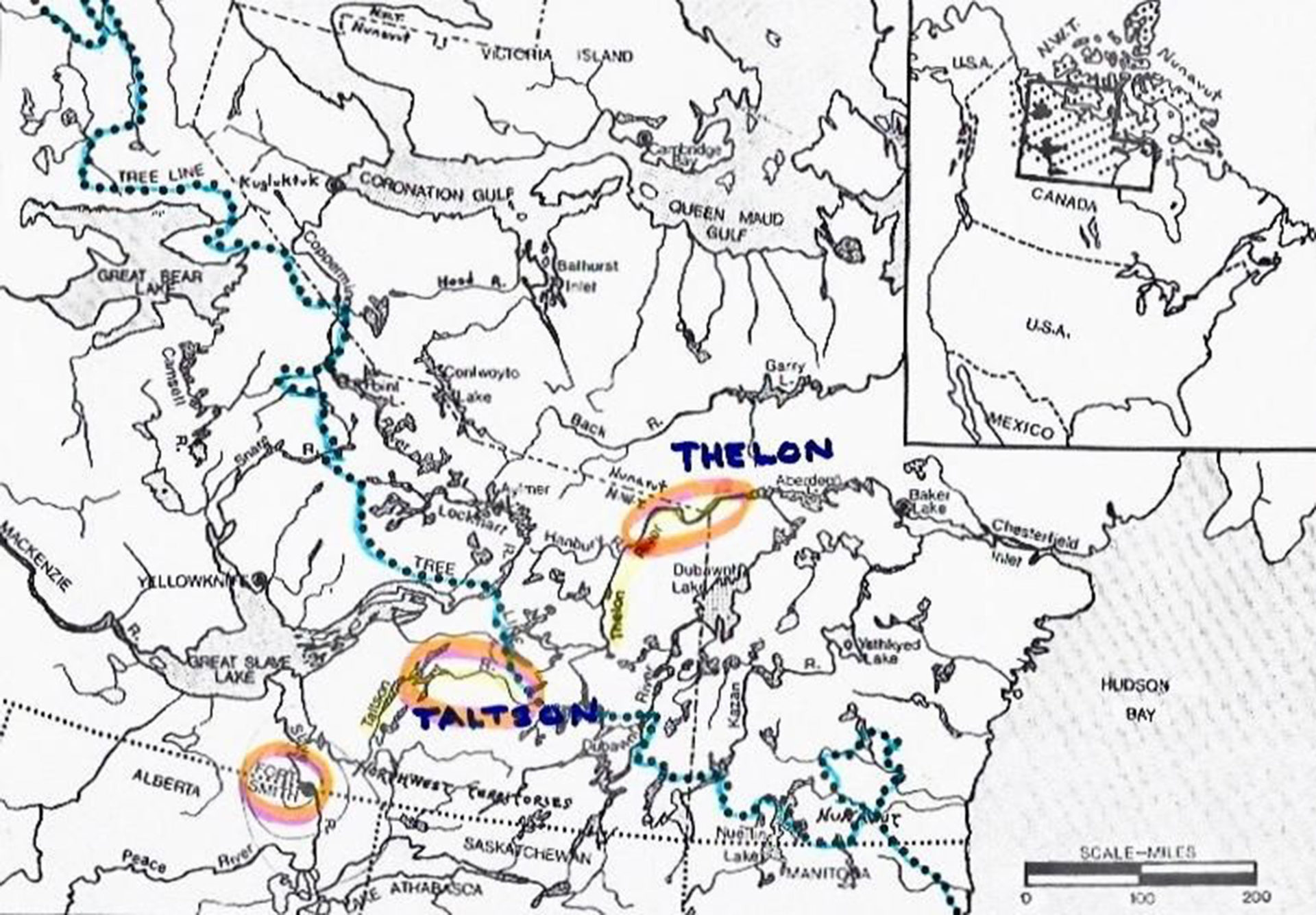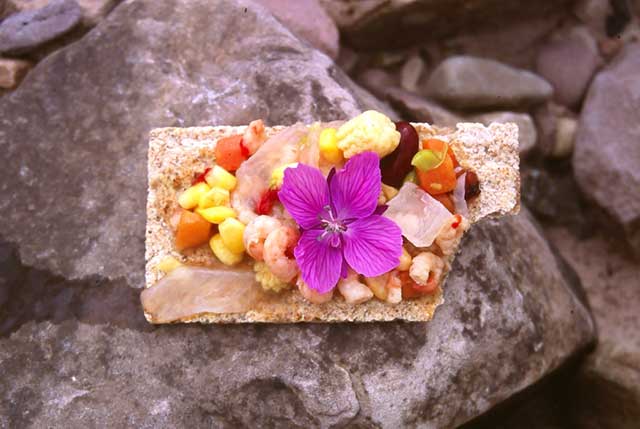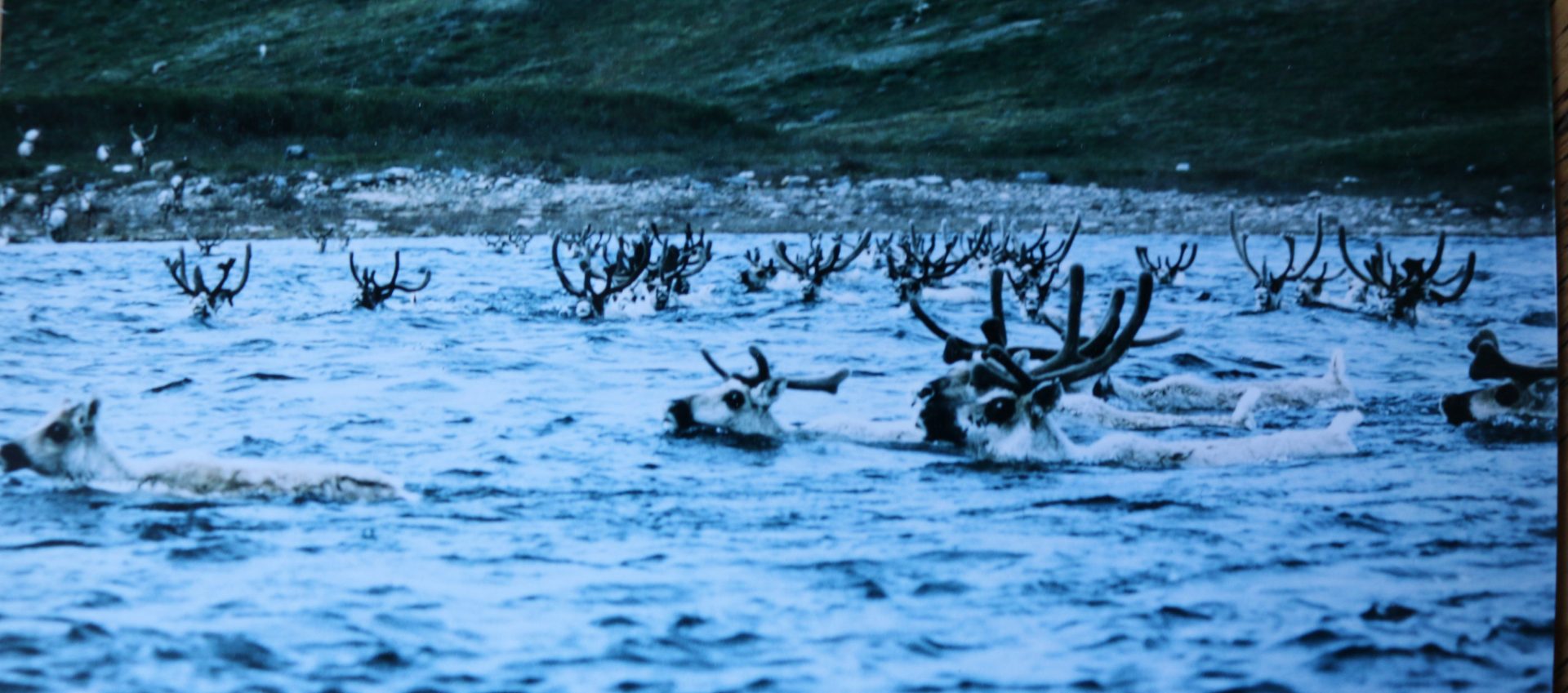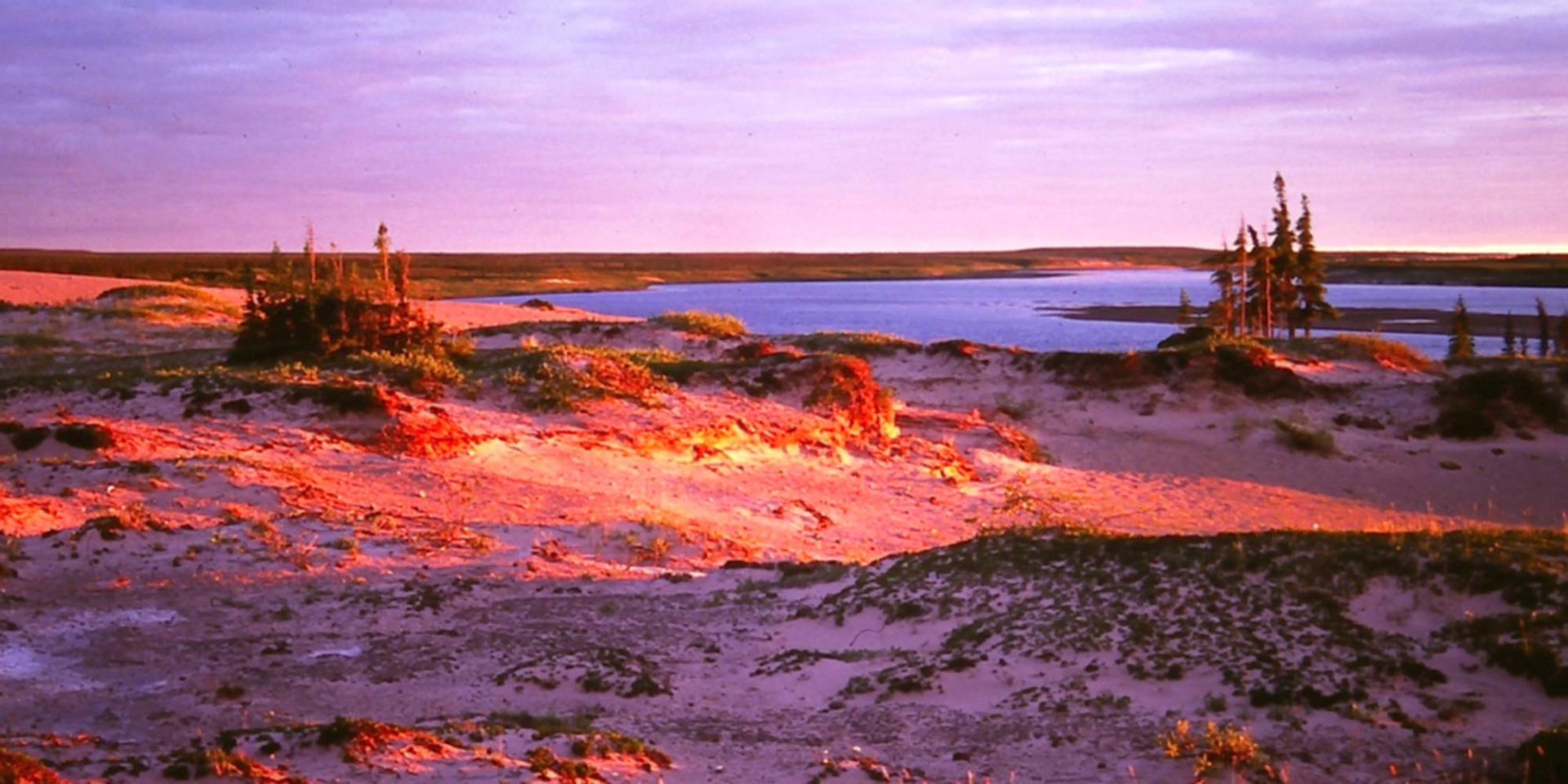
This trip report is written by Peter Heinz, on a guided canoe trip with Alex Hall from Canoe Arctic Inc. Peter knew Alex since 1960 when they were roommates at Western University. Peter was asked to be a fill-in canoeists on four of Alex Hall’s trips over an eleven year span, sparking his interest in the North. Here is the story, in Peter’s words, from one such trip.
The dotted Blue line shows the treeline. The taiga zone lies between the tundra of the north and the temperate forests to the south. It is in these more heavily forested areas that wildlife overwinter before passing through the sparsely forested area to the north and onto the treeless tundra or barren lands with its lack of trees. The Thelon River is well above the treeline as it passes from the Northwest Territories into Nunavut. Firewood for cooking is available south of the treeline, but propane is necessary on the Thelon River because of the lack of wood.

Friday, July 10, 1998 – It is 11 PM and I’m on the Red-eye Special headed for Edmonton. A spectacular display of rolling lightning greeted us as we cruised over Saskatchewan and Alberta. Saskatoon appeared bright and clear, but then clouds set in. During my brief sleep in a Nisku hotel near the Edmonton Airport, I was aware of heavy rain pelting the roof. On checkout, I learned that the storm was severe with many power outages, some even in the hotel. The other news was that the mosquitoes were out in record force, prompted by recent rains.
July 11 – What can I say! It had not rained in Fort Smith since the snow melted and lawns certainly looked that way. The town was sweltering in 35°C heat. Rumour had it, though, that an intensive low pressure was approaching with a severe storm forecast. Alex hoped it would hold off until we got out of town. Alex’s wife had the truck for the day on a trip to Hay River and didn’t return until 10 PM. She was delayed four hours when forest fires forced closure of the highway. We loaded gear into it in the dark.
July 12 – The four-hour flight to the Thelon River took off at 8AM. I was co-pilot in the smaller aircraft carrying four of us. A smoky haze followed us most of the way until we neared our landing spot. Trees are scarce here, growing in a stunted form in wet valleys. Hills of sand and limestone dominate the landscape. Mistake #1 was to wear my hiking boots on the plane, for we stepped directly from the pontoon tip into the river. This means I wore my rubber boots for a hike we embarked on once at the campsite. Three of us trekked miles inland, climbing hill after hill and came close to a cow caribou.


Jul 13 – We paddled a mere 5 km today, fighting waves and a 40 km/h wind. The temperature dropped 15° in a 10 minute period. We made an emergency stop to allow Alex to walk back to where he rescued one canoe that could not handle the high waves. With increasing winds and a darkening sky, we carved out crude tent sites and were set up by 3PM. One of the women was totally soaked after falling into the river twice as she tried lining their canoe.
Alex took us to a teepee ring, two chipping sites and his secret cache of arrowheads and knives. One was a perfectly-formed head with notches indicating it was about 800 years old. Situated on high points of land, these sites provided vistas of the river where caribou traditionally cross. Indigenous people’s passed time chipping spear and arrow points in preparation for the hunt.
July 14 – I didn’t die that night, but just roasted until I finally shed my cocoon. Because a strong wind persisted, we hiked back to where I had gone alone the afternoon before. Today, it was different. Alex spotted a hillside of caribou and we were off.
Before long, we were surrounded by animals, scattered yet close, for caribou blend in well with rocks and vegetation. Alex guessed the herd to be couple of thousand, but expressed concern there were no calves. He had not seen this before. Just as well, for we spotted a large white wolf pacing back-and-forth. What a great morning!

July 15 – Against a stiff breeze we covered 30 km and were dead-tired. I messed up a bit on the second set of rapids and we had to jump out to steady the canoe. Very refreshing, except my feet looked like prunes at the end of the day. My Trimmi rubber boots, now on their third trip, seemed to have acquired a small puncture in the left sole. Good for draining out the water, I always say.
We had two dudes from Indianapolis drop by at 8 AM and they had been on the go since 2 AM. Must try that sometime. Alex was so protective of his sites and knowledge that he appeared to know nothing about anything. Those guys must have felt sorry for the rest of us with a clueless guide like that. Their night travelling was one way to make progress because wind usually dies down for the speed gained from a fast-flowing current can be negated by an oncoming wind. Remember, it never got dark.
We crept up on a muskox today. Some got good close-up pictures; I got the rear end entering the dense brush. Neither caribou nor muskox are creatures of beauty. The muskox on the shoreline are mostly rejected males. Cows and calves are farther inland.


July 16 – On this calm and clear day, the fast flowing river enabled us to gain 31 km. We visited two empty wolf dens, one decayed cabin in which Hornby, Allard and Christensen perished in 1927, and prowled in search of muskox. We camped high up on a cliff at a bend in the river and stored our five canoes in a dry gully. Alex was hit here one time by an unbelievable downpour that turned the dry gully into a river deep
enough to canoe and my tent- site into a sea of mud.
After setting up, I hiked along a tiered sandstone shelves that rose like a cliff. At the far end, I took off my clothes and got clean and wet. I had soap but no towel, so used my trouser legs to dry off. Back in the tent, I realized it was not on level ground. My seat was in a depression that kept me from sliding out the door. My hip did the same once I was horizontal. It would not have been such a big deal had I not pitched my tent on the edge of a cliff.
Friday July 17 – We paddled 40 km today in a leisurely manner. Instead of big game, we saw red fox, arctic hare, peregrine falcons, rough-legged hawks, and a gyrfalcon nest with one huge baby in it. The going-price for this chick would fetch $50,000 in the Middle East to use for hunting.
Last night around 11 PM, several caribou crossed the river near the campsite around 11 PM.

July 18 – Today’s Stop #1 was an abandoned wolf den, #2 where two muskox bulls dozed on the beach. While Alex remained in the canoe and the rest of the canoeists on the shoreline, I crept closer with camera in hand because I did not have a telephoto lens. Watching them through my lens, I was mesmerized by them rubbing their horns on the bushes. Turns out they were stimulating some gland because they were annoyed by my approach.
Suddenly, they became very large when both charged. I yelled and threw up my arms. Fortunately they stopped. Have you ever made sweet talk from six feet away with two angry muskoxen blowing foam onto your jacket from their blackfly-covered snouts? While Alex’s only seen two charges in hundreds of encounters, I set myself up for the first termination. Think about it – how many of your friends have been gored by a rampant muskox? At Stop #3, we watched two black wolf cubs from a short distance. Black babies are rare. Alex howled, got a response, but neither came closer. As we lunched at that spot, we heard the babies and parents call to each other until they were united. On Stop #4, we saw a moose watching us from across the river.
July 19 – While cold, the wind did not work against us as we paddled. Wolves were on the agenda and we were rewarded with an occupied den and at least two wolf cubs. From a not-so-distant ridge, a large white adult howled and barked at us, but did not approach. Alex’s howl lured the young out of the den several times. Wolves, like dogs, were not dangerous as they had never seen a human harm one of their cubs.
Again, from high above a gravel beach, I watched the sun dip at 10:30 PM. Too cold to enjoy but enough to clean up, I braved a skinny dip down the beach from the camp. I left the tent flaps open for the sky was beautiful, the breeze light, and it promised to be warm by morning.




July 20 – What a rip off! Rain took advantage of my open-door policy and soaked the feet of my
sleeping bag.
Takedown was delayed while the tents dried, then we headed off against very strong winds. After the first hour, we had covered only 2 km and were pooped out. By lunch, we knew that we would never cover the necessary additional 15 km stretch to be on schedule for a good rendezvous spot for the float planes.
Our trip was over, for this spot called Caribou Crossing, was the last safe pick-up spot. Alex was disappointed we could not make it to Beverly Lake; no one else was. We signed on for an experience, not necessarily a
lengthy canoe trip.
Our campsite for the next two nights, again, was high on a flat tundra plain overlooking the river. Out back of the tents was a flat bog with several small valleys valleys and uneven ground caused by frost upheaval. An organized hike doubled as a firewood-gathering trip for we have exhausted all the canisters of propane. Wood was scarce above the tree line, making the stove a necessity for at least three days of our trip.
July 21 – There was a mosquito in the tent all night and because she didn’t bite me, I graciously let her go in the morning.
Today’s gourmet lunch was the Crabmeat Special reserved for the last day of the trip.
It was a good move staying at this site. We would’ve made no progress on the river for the winds were very strong and not in our favour. We would never have reached an ideal pickup stop. Alex phoned the air charter people this afternoon. Because they’re short one plane, a smaller one will fly halfway tonight for a 7 PM transfer of one canoe to the next starting point. Then, both aircraft will be here at 10 AM for our evacuation.
July 22 – Alex said we experienced August weather and temperature but it sure beat the hot stuff. While wildlife could’ve been more prolific, the bugs were usual. Alex wanted to reach Beverley Lake, but the three weaker paddlers slowed us down.
The 10 PM tonight I heard a funny noise, stuck my head out the door, and watched a caribou down below on the beach nosing around our canoes and food packs.

July 23 – That darn caribou cost me a whole night’s sleep, for. where there is one, there might be 1000s and I wanted to be first to see them.
When the Otter and Beaver aircraft returned at 11 AM, we loaded, took off, then landed an hour later to drop off and reassemble the canoes, ate peanuts and fruit mix and we were off once again. What a long trip-from 11:20 AM to 4:30 PM covering 650 kilometres cooped up in tiny planes. White plumes rose from many forest fires and as we neared Fort Smith, the sky was heavy with smoke.
Back in the famous Fort Smith bookshop, I finally bought David Pelly’s Thelon: A River Sanctuary. I was tempted twice before, but never expected to actually paddle the Thelon. I’ve seen firsthand the potential for hardship, starvation, or disaster without proper planning. I now have felt the tug of the river, the strength of the wind and the unpredictability of wildlife. I had a great experience and thank Alex for the opportunity.
Interested in experiencing the Thelon River for yourself? You can learn more about our guided canoe trip on the Upper Thelon River here.